Grasshopper
There are 11,000 known species!
Advertisement
Grasshopper Scientific Classification
Read our Complete Guide to Classification of Animals.
Grasshopper Conservation Status
Grasshopper Facts
- Favorite Food
- Grass
- Common Name
- Grasshopper
- Number Of Species
- 11000
- Location
- Worldwide
- Slogan
- There are 11,000 known species!
View all of the Grasshopper images!

Grasshoppers comprise one of the oldest insect families on earth. The first grasshoppers probably appeared 250 million years ago during the Triassic period.
They belong to the Arthropoda phylum, which includes other insects as well as spiders, scorpions, crabs, and their relatives. Phylum is a category that biologists slot living things into, and Arthropoda, which means “joint-footed” is the largest phylum.
Grasshoppers also belong to the Caelifera suborder as well as a multitude of families, subfamilies, tribes, subtribes, and species. They’re found all over the world save Antarctica.
6 Incredible Grasshopper Facts!
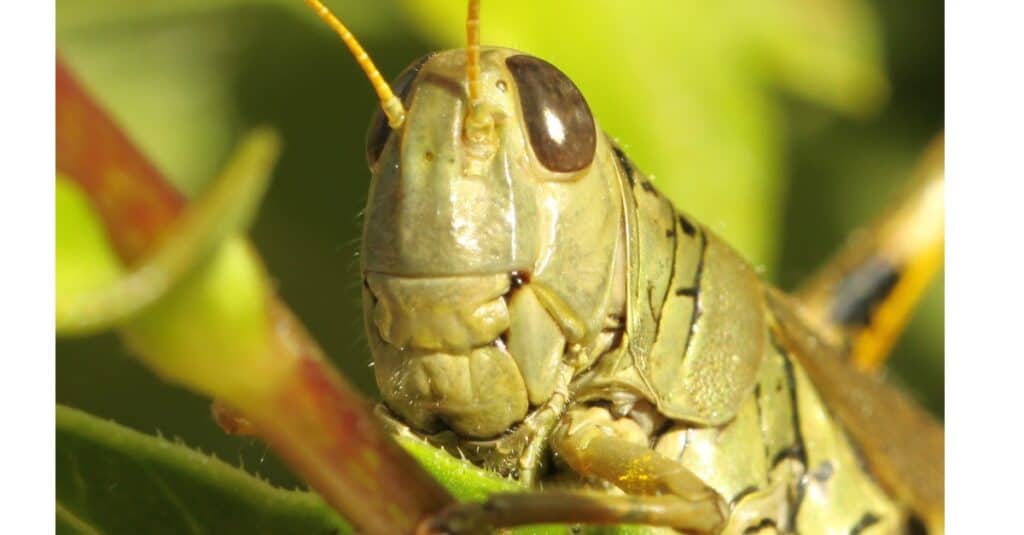
Grasshoppers don’t undergo complete metamorphosis the way many other insects do. They hatch out as nymphs or hoppers, which simply look like tiny, wingless adults.
©iStock.com/nrpphoto
- Grasshoppers don’t undergo complete metamorphosis the way many other insects do. They hatch out as nymphs or hoppers, which simply look like tiny, wingless adults. It takes them five molts to reach adult size.
- Under the right conditions, grasshoppers can change their characteristics, including their color and even their behavior to form great swarms.
- There are places on earth, such as Indonesia and Africa, where grasshoppers are a regular part of the diet. They are a good source of protein.
- Acridology is the study of grasshoppers.
- Scientists know of at least 11,000 species of grasshopper, but they are certain there are more to be discovered.
- The largest grasshopper in the world is the hedge grasshopper. The species lives in Australia and can grow to 3.5 inches in length!
You can check out more incredible facts about grasshoppers.
Species, Types, and Scientific Names
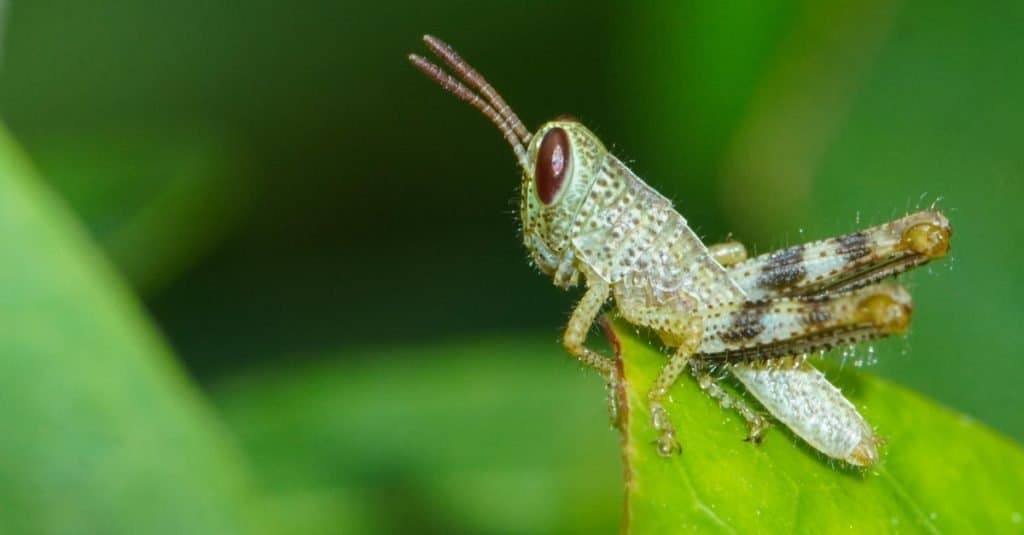
The known 11,000 plus species and types of grasshoppers can’t be listed in this space, but one of their defining characteristics is the ability to leap many times their own body length.
©Lemonade Serenade/Shutterstock.com
The known 11,000 plus species and types of grasshoppers can’t be listed in this space, but one of their defining characteristics is the ability to leap many times their own body length.
A “typical” grasshopper can jump 10 times its height and 20 times its length. They hop to escape predators or just because they need to move from one place to the other. Learn more about the highest jumping animals on earth here.
Many species are so well camouflaged that they seem to disappear when they hide in the tall grass. On the other hand, when they’re disturbed some species open their wings and startle potential predators with a bright flash of color.
There are three types of green-striped grasshoppers. They are:
- Green-striped grasshopper, whose scientific name is Chortophaga viridifasciata.
- Southern green-striped grasshopper, whose scientific name is Chortophaga viridifasciata australior.
- Northern green-striped grasshopper, whose scientific name is Chortophaga viridifasciata viridifasciata.
There are six types of Xanthippus grasshoppers:
- Sierra grasshopper, whose scientific name is Xanthippus sierra.
- Sandhills band-wing grasshopper, whose scientific name is Xanthippus montanus.
- Redshanked grasshopper, whose scientific name is Xanthippus corallipes.
- Xanthippus aquilonius
- Xanthippus olancha
- Xanthippus brooksi
There are three types of Differential grasshoppers:
- Differential grasshopper, whose scientific name is Melanoplus differentialis.
- Melanoplus differentialis differentialis
- Melanoplus differentialis nigricans
The full list of representative species of grasshopper includes the following:
- Conozoa hyalina
- Trimerotropis occulens
- Omocestus viridulus
- Eastern lubber grasshopper
- Migratory locust
- Atractomorpha crenulata
- Desert locust
- Chorthippus brunneus
- Brown locust
- Red-legged grasshopper
- Gray bird grasshopper
- Pseudochorthippus parallelus
- Chinese grasshopper
- Chorthippus biguttulus
- Large Marsh Grasshopper
- Atractomorpha similis
- Two-striped grasshopper
- Rocky Mountain locust
- Acanthopyrgus finoti
- Australian plague locust
- Pallid-winged grasshopper
- Atractomorpha lata
- Ceracris kiangsu
- Red locust
- Calliptamus italicus
- Oedipoda caerulescens
- Violet-winged grasshopper
- Oedaleus infernalis
- Chorthippus albomarginatus
- Slender Blue-winged Grasshopper
- Chrysochraon dispar
- Chorthippus dorsatus
- Phymateus aegrotus
- Chorthippus pullus
- Podisma pedestris
- Zayante band-winged grasshopper
- Spur-throated locust
- Trimerotropis fontana
- Melanoplus bispinosus
- Chorthippus acroleucus
- Schistocerca camerata
- Eximacris superbum
- Prionotropis ancosae
- Austracris proxima
- Phaulacridium crassum
- Opeia obscura
- Phaulacridium vittatum
- Trimerotropis thalassica
- Trimerotropis occidentiloides
- Stauroderus scalaris
Evolution and Origins
Grasshoppers are insects that belong to the suborder Caelifera within the order Orthoptera. They are believed to have evolved from a common ancestor around the Triassic period, around 220 million years ago. Fossil evidence shows that grasshoppers have remained relatively unchanged in terms of their physical characteristics and behavior over the course of their evolutionary history.
They have a distinct body plan, characterized by a large head, long antennae, and powerful hind legs, which are adapted for jumping. The origins of the grasshopper are not well understood, but it is believed to have evolved from a common ancestor with other Orthopterans like crickets, katydids, and locusts.
Their evolution is characterized by the development of the hind legs and the ability to jump, which allowed them to escape predators and move quickly in search of food.
Appearance
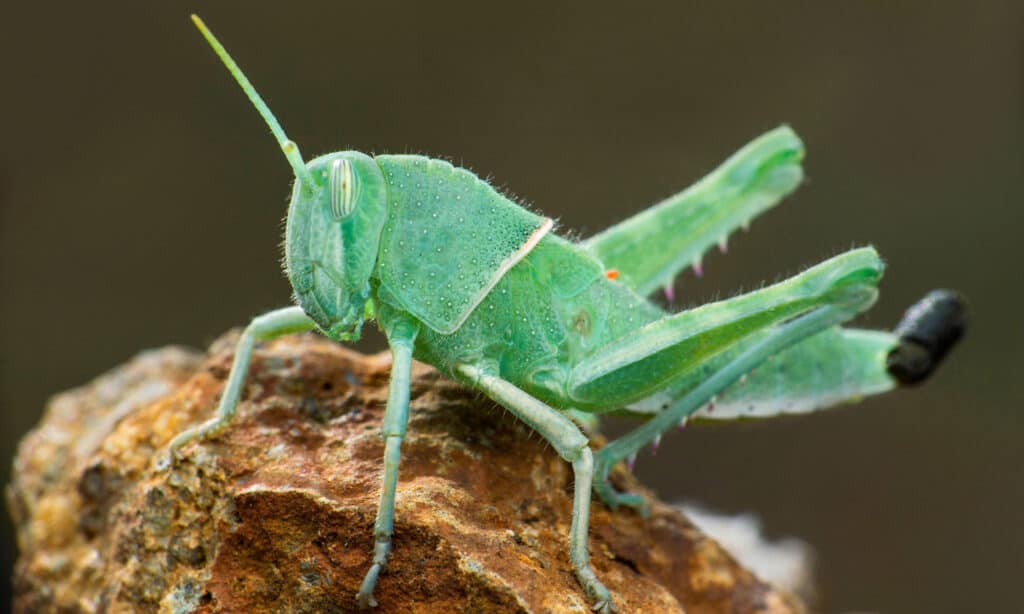
Grasshoppers are herbivore insects.
©RealityImages/Shutterstock.com
Grasshoppers can look surprisingly different from each other, and some don’t quite look like grasshoppers at all. The leaf grasshopper, Phyllochoreia ramakrishnai for example, mimics a fresh green leaf. But what they all have in common are the usual characteristics of an insect, which is a body plan that has a head, a thorax, and an abdomen.
The grasshopper’s head is arranged vertically at a not quite 90-degree angle at the front of the thorax, and its mouth is found at the bottom of the head. The jaws there allow the grasshopper to bite and chew its food, though it doesn’t bite people.
Grasshoppers have two large compound eyes, three simple eyes, and a pair of antennae that serve as organs of smell and touch. Biologists use the length of the antennae to determine whether the insect is an “ordinary grasshopper” or a locust. An ordinary grasshopper’s antennae are long, while those of a locust is short.
The grasshopper’s thorax and abdomen have segments made of chitin. The animal’s six legs and wings, if it has wings, are found on the thorax. The final pair of legs are diagnostic for the grasshopper because they are powerful, with strong “thighs.” The back edge of the legs has spines and spurs.
The grasshopper’s abdomen has 11 sections. The first is attached to the thorax and holds the insect’s auditory system. The last four segments are reduced, and the last two have the insect’s reproductive organs. Female grasshoppers are usually bigger than males, and their ovipositors give the suborder its name. Caelifera is a Latin word that means “chisel-bearing.” This refers to the ovipositor’s shape and how it is used to drill down into the ground so the female can lay her eggs.
Some types of grasshoppers make noise or stridulate by rubbing pegs on their hind legs against parts of their forewings. It’s usually males who stridulate to attract mates, but females have been known to stridulate. Other grasshoppers make a clacking sound when they fly by clashing their front and hind wings together.
Grasshoppers are usually solitary, but when conditions are right, they can form groups called swarms. Swarms are sometimes made up of billions of individuals.
Adult grasshoppers range in size from 0.39 inches to 2.75 inches, depending on the species. The average weight of a grasshopper is 0.01 ounces, and most grasshoppers are shades of green or brown. Some species, such as the horse lubber and the rainbow grasshopper, have a coloring that mimics the coloring of wasps. Grasshoppers’ colors serve as camouflage or to fool would-be predators into thinking they are dangerous. The lifespan of a grasshopper is around 12 months.
Habitat: Where to Find Grasshoppers
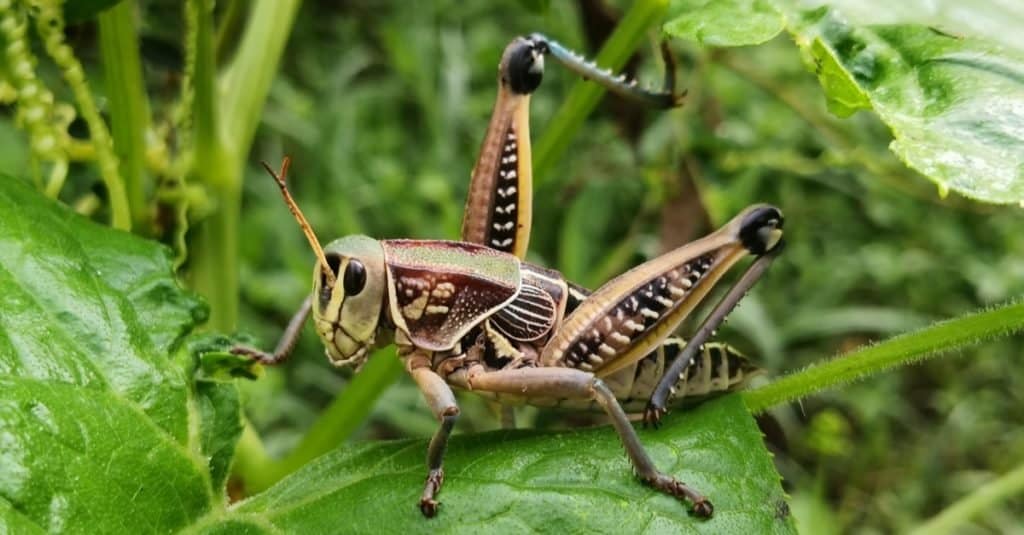
©NEFS/Shutterstock.com
The grasshopper’s name gives a clue as to where it can be found. It is found in habitats where grass and other food plants are abundant. This means, basically, any place on earth where it is not extremely dry or extremely cold.
Many species of grasshoppers prefer places where plants do not grow very tall, though some can be found in moist forests or jungles. Grasshoppers are also easily found in urban parks and suburban yards and gardens.
Diet: What Do Grasshoppers Eat?
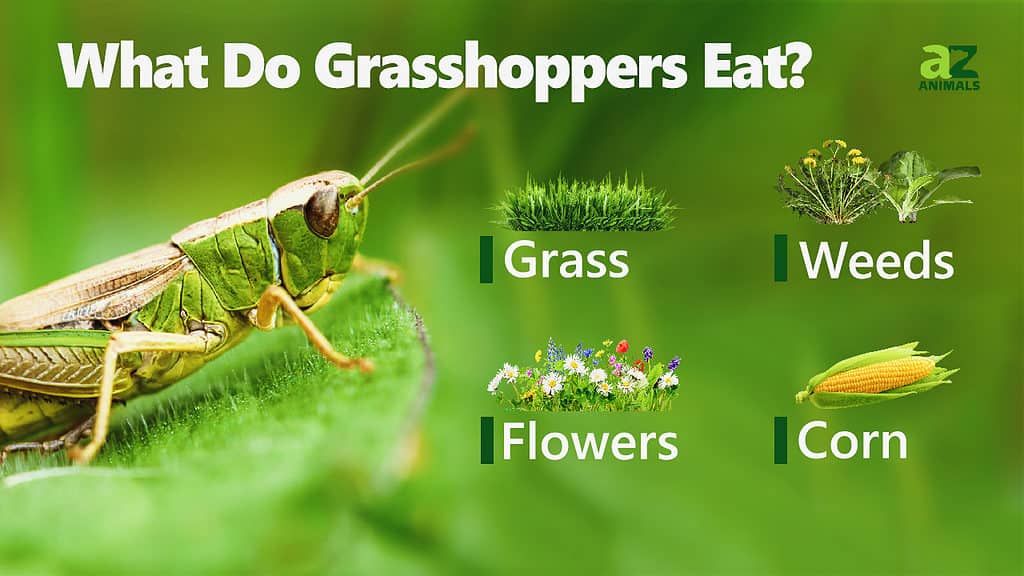
Grasshoppers, famously, eat all manner of plants, even those grown on farms. This makes them considerable pests in many areas of the world. They will eat new, tender leaves, flowers, and stems. Some grasshoppers eat poisonous plants to transfer that poison into their own bodies to make them distasteful to predators. They also eat seeds, and sometimes they will eat dead insects. Locusts have been known to eat each other when food is scarce.
Grasshoppers aren’t fussy about the plant material they eat, but plants sprayed with enough pesticide can kill them. It’s not unusual for a grasshopper to eat 16 times its own weight at a sitting.
Want to learn more about what grasshoppers eat? Check out our complete guide ‘What Do Grasshoppers Eat.‘
Prevention: How to Get Rid of Grasshoppers

The pink grasshopper, also known as a katydid, is the result of a genetic mutation.
©iStock.com/chris2766
Normally, grasshoppers don’t do too much damage to lawns and gardens. They fall prey to a great many predators such as ants, tachinids,s and robber flies, spiders, birds, cats, and dogs. They are also subject to many sorts of diseases.
Most grasshoppers don’t even manage to hatch out of their eggs, and nearly all die during the winter in places where the winters are very cold. Even those who aren’t winter-killed only live for a few years if they avoid predators or disease.
Grasshoppers can become a huge problem when they swarm. Scientists really don’t know why locusts form swarms. It might be because lots of rainfall made food abundant and caused the population to explode.
It might also be because conditions were dry, warm, and sunny and also caused the population to explode. When the food runs out, the swarm takes to the air and flies in search of more of it. It won’t matter if it’s a field of wheat or another crop that a farmer needs to make a living.
The best way to control grasshoppers is to make the environment unattractive to them. This may be as simple as removing the tough weeds near drainage ditches that are near croplands or gardens.
Farmers and gardeners can mix a grasshopper parasite called Nosema locustae with bait, infect the insects with Metarhizium acridum, a type of fungus, or spray plants with neem oil. Insecticides are not very effective for tough and mobile adult grasshoppers, though they might work on hoppers.
View all 170 animals that start with GGrasshopper FAQs (Frequently Asked Questions)
Are Grasshoppers herbivores, carnivores, or omnivores?
Since grasshoppers mostly eat plants, they are herbivores.
What Kingdom do Grasshoppers belong to?
Grasshoppers belong to the Kingdom Animalia.
What class do Grasshoppers belong to?
Grasshoppers belong to the class Insecta.
What phylum to Grasshoppers belong to?
Grasshoppers belong to the phylum Arthropoda.
What family do Grasshoppers belong to?
Grasshoppers belong to the family Caelifera.
What order do Grasshoppers belong to?
Grasshoppers belong to the order Orthoptera.
Where do Grasshoppers live?
Grasshoppers are found worldwide.
In what type of habitat do Grasshoppers live?
Grasshoppers live in fields and meadows.
What is the main prey for Grasshoppers?
Grasshoppers eat grass, weeds, and shrubs.
What are some predators of Grasshoppers?
Predators of Grasshoppers include birds, rodents, reptiles, and insects.
How many babies do Grasshoppers have?
The average number of babies a Grasshopper has is 4.
What is an interesting fact about Grasshoppers?
There are 11,000 known species of Grasshopper!
How many legs does a grasshopper have?
Grasshoppers have six legs.
What is a grasshopper?
A grasshopper is an insect known for its ability to jump many times the length of its body due to its powerful hind legs.
Is a grasshopper an insect?
A grasshopper is a type of insect.
Are grasshoppers dangerous?
Grasshoppers may not be dangerous to people, but great swarms of grasshoppers called locusts can destroy crops. When crops are destroyed, whole populations of humans can be subject to famine and even diseases such as cholera. Grasshoppers don’t sting or bite people, but some of the relatives they’re mistaken for do. The green katydid, for example, can deliver a rather sharp bite.
Are grasshoppers good luck?
In many places around the world, the grasshopper is a sign of good luck. It also symbolizes peace, courage, joy, freedom, creativity and other good things.
What are the differences between a grasshopper and a praying mantis?
When comparing a grasshopper vs a praying mantis, the praying mantis is generally larger and is a carnivore whereas grasshoppers eat plants.
Can grasshoppers fly?
Most grasshoppers can fly at least short distances though some, such as the Puer Group, do not.
What's the difference between a grasshopper and a katydid?
Grasshoppers are herbivores, while katydids are omnivores. Additionally, the songs of katydids differ greatly from grasshoppers.
Thank you for reading! Have some feedback for us? Contact the AZ Animals editorial team.
Sources
- Health Line, Available here: https://www.healthline.com/health/katydid-bite
- Oak Trust, Available here: https://oaktrust.library.tamu.edu/handle/1969.1/173138
- The Astrology Web, Available here: https://www.theastrologyweb.com/spirit-animals/grasshopper-meaning-symbolism
- Wikipedia, Available here: https://en.wikipedia.org/wiki/Grasshopper
- Britannica, Available here: https://www.britannica.com/animal/grasshopper-insect
- EOL, Available here: https://eol.org/pages/43585
- University of Wisconsin, Available here: https://uwm.edu/field-station/melanoplus-grasshoppers-redux/
- New World Encyclopedia, Available here: https://www.newworldencyclopedia.org/entry/Caelifera
- Ecotourism World, Available here: https://ecotourism-world.com/can-grasshoppers-be-a-sustainable-food-source-of-protein/

















